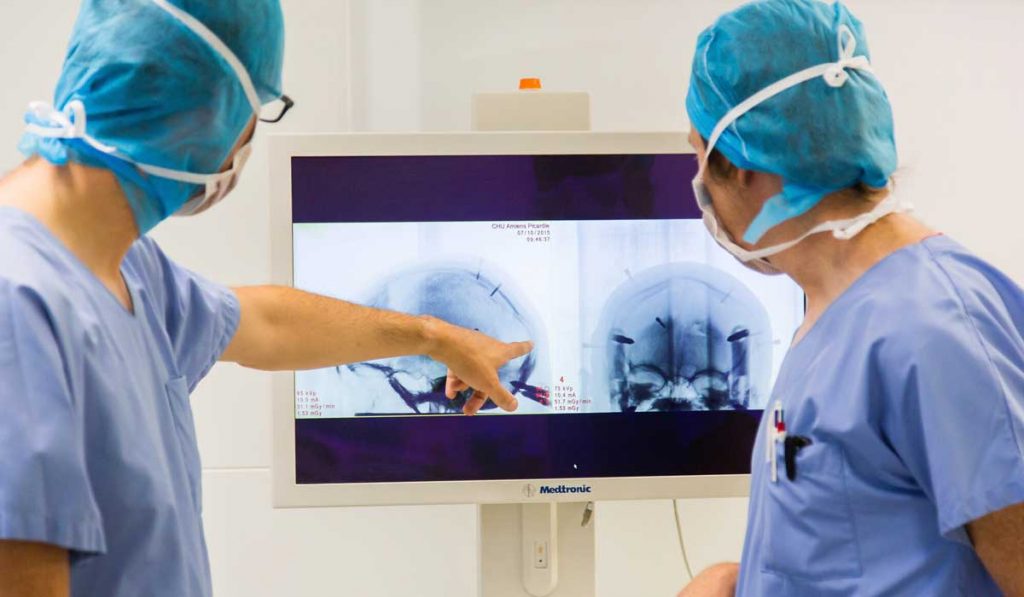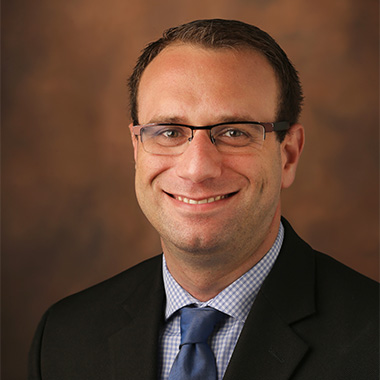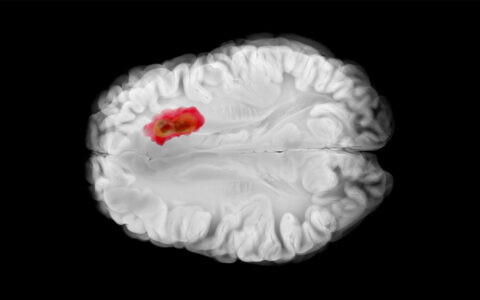Deep brain stimulation (DBS) was first approved by the FDA in 1997 to treat patients with movement disorders. David Charles, M.D., a professor and vice chair of neurology at Vanderbilt University Medical Center, started the Vanderbilt DBS program in 1995 and served as the local principal investigator for the Medtronic multicenter trial leading to approval. Vanderbilt continued to pioneer deep brain stimulation use in the management of Parkinson’s disease, dystonia and essential tremor.
Since then, it has been refined and approved for epilepsy and obsessive compulsive disorder. Now, its use is being explored in several other psychiatric and neurological disorders.
“We treat about 120 patients per year with DBS, and we see symptom improvement and the staying power of this technology.”
“DBS has always been a minimally invasive procedure, but today risks are lower than ever before, and it is a more comfortable procedure for the patient,” said Dario Englot, M.D., director of functional neurosurgery at Vanderbilt. “Directionality in the DBS leads now allows for more specific targeting of identified circuits, raising success odds. Closed loop stimulation is becoming dynamic and will soon allow for communication between brain recordings and the pulse generator.”
Fenna Phibbs, M.D., an associate professor of neurology at Vanderbilt, says she now has access to tools used to personalize programming based off the exact location of the deep brain stimulation electrode within the patient’s brain from imaging. “We are better able to find the best area to stimulate without as much trial and error,” she said. “DBS lead design has also improved, allowing for precision control of stimulation so that delivery of current to areas of the brain involved in the disease process is optimized and other areas are avoided.”
From ECT to Multiple Neuromodulators
DBS factors heavily into the history of electrical stimulation for neurological disorders, stretching from early electroconvulsive therapy (ECT) to today’s array of options – including vagus nerve stimulation (VNS) and responsive neurostimulation (RNS).
“We are better able to find the best area to stimulate without as much trial and error.”
An understanding of why DBS works lags behind evidence of its effectiveness. What is increasingly borne out is that targeted use in the appropriate circuit to stimulate, quell or disrupt dysfunctional circuits helps normalize brain function.
Advantages over other neuromodulation procedures are its non-lesional nature, the ability to titrate stimulation and, overall superior outcomes. A study comparing VNS with DBS in major depression and bipolar depression studies found DBS to be more effective than (non-ECT) alternatives. Recent studies found that DBS edged out VNS in median seizure reduction and responder rates in patients with epilepsy.
DBS Today
As of 2019, over 160,000 patients worldwide have undergone DBS for a variety of neurological and other conditions. “Studies demonstrate a 69 percent reduction in seizure activity in epilepsy patients and very favorable response rates among movement disorder patients,” Englot said.
“We treat about 120 patients per year with DBS, and we see symptom improvement and the staying power of this technology. Despite the rising numbers of DBS procedures, there are many who could be helped but aren’t fully aware of the options, or just aren’t referred. We hope to see that change more rapidly as word gets out about the advancements and expanding applications.”
Innovations at Vanderbilt
DBS surgical planning at Vanderbilt now encompasses a combination of functional and structural MRI to create 3D volumetric reconstructions of a patient’s brain. “Traditionally we looked at a standard set of MRI sequences for targeting electrode placement. Increasingly, we are exploring advanced imaging protocols to examine structural and functional connectivity patterns that may improve target selection and outcome prediction,” Englot explained.
Vanderbilt investigators were involved in the development of STarFix Stereotactic Platforms, which enable DBS procedures to be performed without rigid frame fixation, improving comfort.
Innovators are on the cusp of offering closed loop stimulation in DBS, which will provide feedback from the basal ganglia to change stimulation levels, Phibbs said. “It allows for faster and more precise stimulation based off disease-specific brain signals, leading to better control of symptoms and fewer side effects.”
To assist with electrode placement, the DBS team currently uses software developed at Vanderbilt that records brain signals while the patient is awake. “We track recordings and simulations of both sides of the brain at the same time, which is pretty unique,” Englot said. “Based on all patients’ recordings, we are building an atlas – a 3D representation of the brain that marks ideal sites for stimulation. This atlas helps us target likely best sites for electrode placement in future patients.”
Expanding Indications for DBS
In 2018, Charles’ team led the only FDA-approved trial of DBS in very early-stage Parkinson’s disease, demonstrating its efficacy in slowing the progression of motor symptoms. “Based on that trial – we now have FDA approval to lead a large-scale, phase 3, multicenter trial of DBS in early-stage Parkinson’s disease,” Charles said.
Beyond movement disorders, research demonstrates DBS may improve memory and cerebral metabolism in patients over 65, and Vanderbilt is using animal models to explore its potential in treating Alzheimer’s disease. Specific studies are also in the planning stage to look at how DBS may enhance learning and memory in patients with abnormalities in basal ganglia circuitry.
DBS is now in clinical trials for major depression, eating disorders, Tourette syndrome, pain, addiction and schizophrenia. Vanderbilt has recently added a neurologist who will specifically research DBS in pain management and psychiatric disorders.






